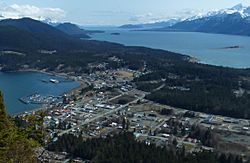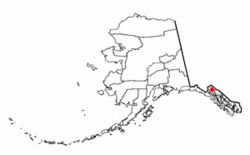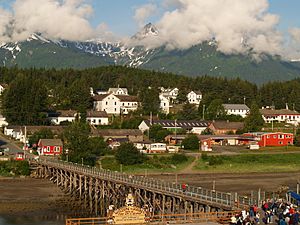Haines, Alaska facts for kids
Quick facts for kids
City and Borough of Haines
Deishú
|
|
|---|---|
|
Home Rule Borough
|
|

Haines, viewed from the northeast from Mount Ripinsky with Chilkoot Inlet on the left, Chilkat Inlet on the right, and the Chilkat Peninsula extending into the distance
|
|
| Motto(s):
The Adventure Capital of Alaska
|
|

Location of Haines, Alaska
|
|
| Country | United States |
| State | Alaska |
| Borough | Haines |
| Incorporated | January 24, 1910 |
| Disincorporated | October 17, 2002 (consolidated with a reincorporated Haines Borough) |
| Area | |
| • Total | 20.69 sq mi (53.58 km2) |
| • Land | 13.25 sq mi (34.32 km2) |
| • Water | 7.43 sq mi (19.25 km2) |
| Elevation | 36 ft (11 m) |
| Population
(2020)
|
|
| • Total | 1,657 |
| • Density | 125.03/sq mi (48.27/km2) |
| Time zone | UTC-9 (Alaska (AKST)) |
| • Summer (DST) | UTC-8 (AKDT) |
| ZIP code |
99827
|
| Area code | 907 |
| FIPS code | 02-31050 |
| GNIS feature ID | 1422400 |
Haines is a small community in Alaska, United States. It is located in the northern part of the Alaska Panhandle. It is also close to Glacier Bay National Park and Preserve. In 2020, about 1,657 people lived in Haines. This makes up most of the population of the wider Haines Borough.
Contents
History of Haines
The original name for Haines was Deishú. This name was given by the Chilkat group of the Tlingit people. It means "end of the trail". They used this name because they could carry their canoes from a trade trail to this spot. This shortcut saved them about 20 miles of rowing.
The first European to settle here was George Dickinson in 1879. He worked for the North West Trading Company. In 1881, the Chilkat people asked for missionaries. John Muir and Samuel Hall Young, a Presbyterian minister, came to the area. They built the Chilkat Mission and a school in 1881. The Chilkat people gave the land for this mission.
The mission was renamed "Haines" in 1884. This was to honor Francina E. Haines. She led the group that raised money for the mission. Haines is special because it's the only town in Southeast Alaska named after a woman.
Gold Rush and Border Changes
The Klondike Gold Rush from 1896 to 1899 brought big changes. Haines became a key place for supplies. The Dalton Trail from Chilkat Inlet was a path to the Yukon for gold seekers. Gold was found near Haines in 1899.
This made the area very important. The exact border between Canada and the U.S. was unclear. In 1903, a group of American and Canadian-British members decided the border. They chose the border we see today.
Fort William H. Seward
Fort William H. Seward was a United States Army base. It was built south of Haines and finished by 1904. The mission donated the land for the fort. In 1922, the fort was renamed Chilkoot Barracks. It was the only U.S. Army post in Alaska before World War II. During the war, it was used to supply Army activities in Alaska.
The fort closed in 1946. It was sold to a group of investors who called it "Port Chilkoot". This group formed the Port Chilkoot Company. Port Chilkoot became a city in 1956. In 1970, Port Chilkoot and Haines joined to form one city. In 1972, the fort became a National Historic Landmark. Its original name, Fort William H. Seward, was brought back.
Later Years
Haines was the southern end of the Haines-Fairbanks Pipeline. This pipeline carried fuel to military bases from 1955 to 1973. Its building and upkeep were very important for Haines' economy for 40 years.
Most fish canneries closed by 1972. This was due to fewer fish. However, commercial fishing still plays a big role in the local economy. In 2002, the city of Haines and Haines Borough joined together.
Geography and Weather
Haines is located on the Chilkat Peninsula. It sits on a narrow strip of land called the Deshu Isthmus. To the east is Portage Cove of Chilkoot Inlet. To the west is the Chilkat River where it meets the Chilkat Inlet.
Haines has a climate with warm summers and dry periods. Winters are mild for Alaska. The average high temperature in January is around 30°F (-1°C). Summers are cool to mild. The average high in July is about 65°F (18°C).
Haines has seen a lot of snow. In the 2006-2007 winter, it got 309 inches (7.8 meters) of snow. This record was broken in 2011-2012 with 360 inches (9.1 meters) of snow!
| Climate data for Haines, Alaska (Haines Airport) (1991–2020 normals, extremes 1911–present) | |||||||||||||
|---|---|---|---|---|---|---|---|---|---|---|---|---|---|
| Month | Jan | Feb | Mar | Apr | May | Jun | Jul | Aug | Sep | Oct | Nov | Dec | Year |
| Record high °F (°C) | 57 (14) |
53 (12) |
63 (17) |
75 (24) |
84 (29) |
92 (33) |
98 (37) |
95 (35) |
86 (30) |
65 (18) |
65 (18) |
61 (16) |
98 (37) |
| Mean maximum °F (°C) | 43.7 (6.5) |
44.9 (7.2) |
48.4 (9.1) |
61.4 (16.3) |
72.6 (22.6) |
79.6 (26.4) |
77.4 (25.2) |
77.8 (25.4) |
67.7 (19.8) |
56.5 (13.6) |
45.6 (7.6) |
44.0 (6.7) |
83.2 (28.4) |
| Mean daily maximum °F (°C) | 30.1 (−1.1) |
34.1 (1.2) |
38.6 (3.7) |
49.8 (9.9) |
59.5 (15.3) |
64.1 (17.8) |
65.4 (18.6) |
64.2 (17.9) |
57.4 (14.1) |
47.8 (8.8) |
36.3 (2.4) |
31.9 (−0.1) |
48.3 (9.0) |
| Daily mean °F (°C) | 24.4 (−4.2) |
28.0 (−2.2) |
32.5 (0.3) |
42.1 (5.6) |
50.8 (10.4) |
56.6 (13.7) |
58.8 (14.9) |
57.6 (14.2) |
51.6 (10.9) |
42.6 (5.9) |
31.3 (−0.4) |
26.9 (−2.8) |
41.9 (5.5) |
| Mean daily minimum °F (°C) | 18.6 (−7.4) |
22.0 (−5.6) |
26.4 (−3.1) |
34.4 (1.3) |
42.2 (5.7) |
49.0 (9.4) |
52.1 (11.2) |
50.9 (10.5) |
45.8 (7.7) |
37.5 (3.1) |
26.3 (−3.2) |
21.8 (−5.7) |
35.6 (2.0) |
| Mean minimum °F (°C) | 0.4 (−17.6) |
6.2 (−14.3) |
11.3 (−11.5) |
24.3 (−4.3) |
34.4 (1.3) |
41.9 (5.5) |
46.9 (8.3) |
45.0 (7.2) |
35.6 (2.0) |
26.9 (−2.8) |
12.3 (−10.9) |
5.7 (−14.6) |
−4.2 (−20.1) |
| Record low °F (°C) | −18 (−28) |
−16 (−27) |
−7 (−22) |
6 (−14) |
26 (−3) |
30 (−1) |
31 (−1) |
32 (0) |
24 (−4) |
6 (−14) |
−11 (−24) |
−14 (−26) |
−18 (−28) |
| Average precipitation inches (mm) | 4.86 (123) |
3.36 (85) |
3.04 (77) |
2.35 (60) |
1.88 (48) |
1.55 (39) |
1.74 (44) |
3.21 (82) |
5.91 (150) |
6.79 (172) |
5.65 (144) |
7.06 (179) |
47.40 (1,204) |
| Average snowfall inches (cm) | 45.0 (114) |
25.0 (64) |
23.9 (61) |
2.5 (6.4) |
0.0 (0.0) |
0.0 (0.0) |
0.0 (0.0) |
0.0 (0.0) |
0.0 (0.0) |
1.8 (4.6) |
25.7 (65) |
40.0 (102) |
163.9 (417) |
| Average precipitation days (≥ 0.01 in) | 19.7 | 14.9 | 14.5 | 12.6 | 10.0 | 10.9 | 12.6 | 14.8 | 18.5 | 19.5 | 18.4 | 20.2 | 186.6 |
| Average snowy days (≥ 0.1 in) | 12.3 | 9.7 | 7.7 | 1.6 | 0.1 | 0.0 | 0.0 | 0.0 | 0.0 | 1.0 | 8.1 | 13.6 | 54.1 |
| Source: NOAA | |||||||||||||
| Climate data for Haines 40NW, Alaska, 1991–2020 normals: 820ft (250m) | |||||||||||||
|---|---|---|---|---|---|---|---|---|---|---|---|---|---|
| Month | Jan | Feb | Mar | Apr | May | Jun | Jul | Aug | Sep | Oct | Nov | Dec | Year |
| Mean daily maximum °F (°C) | 23.0 (−5.0) |
29.0 (−1.7) |
34.6 (1.4) |
45.6 (7.6) |
57.6 (14.2) |
65.7 (18.7) |
68.2 (20.1) |
66.2 (19.0) |
56.2 (13.4) |
43.5 (6.4) |
29.8 (−1.2) |
24.4 (−4.2) |
45.3 (7.4) |
| Daily mean °F (°C) | 17.4 (−8.1) |
21.5 (−5.8) |
26.0 (−3.3) |
36.3 (2.4) |
46.3 (7.9) |
54.4 (12.4) |
58.1 (14.5) |
56.2 (13.4) |
47.9 (8.8) |
37.3 (2.9) |
24.6 (−4.1) |
19.5 (−6.9) |
37.1 (2.8) |
| Mean daily minimum °F (°C) | 11.7 (−11.3) |
14.1 (−9.9) |
17.3 (−8.2) |
27.0 (−2.8) |
35.0 (1.7) |
43.2 (6.2) |
48.0 (8.9) |
46.1 (7.8) |
39.5 (4.2) |
31.2 (−0.4) |
19.4 (−7.0) |
14.6 (−9.7) |
28.9 (−1.7) |
| Average precipitation inches (mm) | 5.50 (140) |
4.07 (103) |
3.68 (93) |
2.19 (56) |
1.72 (44) |
1.30 (33) |
1.40 (36) |
2.67 (68) |
5.43 (138) |
6.87 (174) |
5.74 (146) |
7.75 (197) |
48.32 (1,228) |
| Average snowfall inches (cm) | 53.10 (134.9) |
38.90 (98.8) |
33.60 (85.3) |
5.60 (14.2) |
0.20 (0.51) |
0.00 (0.00) |
0.00 (0.00) |
0.00 (0.00) |
0.20 (0.51) |
7.60 (19.3) |
44.40 (112.8) |
61.50 (156.2) |
245.1 (622.52) |
| Source: NOAA | |||||||||||||
People of Haines
| Historical population | |||
|---|---|---|---|
| Census | Pop. | %± | |
| 1900 | 85 | — | |
| 1910 | 445 | 423.5% | |
| 1920 | 314 | −29.4% | |
| 1930 | 344 | 9.6% | |
| 1940 | 357 | 3.8% | |
| 1950 | 338 | −5.3% | |
| 1960 | 392 | 16.0% | |
| 1970 | 463 | 18.1% | |
| 1980 | 993 | 114.5% | |
| 1990 | 1,238 | 24.7% | |
| 2000 | 1,811 | 46.3% | |
| 2010 | 1,713 | −5.4% | |
| 2020 | 1,657 | −3.3% | |
| source: | |||
Haines first appeared in the U.S. Census in 1900. It officially became a city in 1910. In 2002, it changed its status to a census-designated place (CDP).
Population in 2010
In 2010, there were 2,474 people living in Haines. There were 1,087 households. Most residents (79.7%) were White. About 10.5% were Native American. The average household had 2.40 people.
The median age in Haines was 40 years old. About 26.7% of the population was under 18. The median income for a household was $39,926.
Things to See and Do
Haines is a popular place for tourists. Many visitors come to see the annual gathering of bald eagles. This happens in the Alaska Chilkat Bald Eagle Preserve from October to February. Haines has the largest group of bald eagles in the world during this time.
Every May, Haines hosts Alaska's longest-running beer festival. It attracts over 1,500 visitors. Haines also hosts the Southeast Alaska State Fair. This four-day event happens on the last weekend of July. It includes vendors, games, rides, and a music festival.
Outdoor Adventures
The area around Haines is great for outdoor activities. People enjoy rafting on the Chilkat River. Hiking in the Takshanuk Mountains is also popular. In winter, activities like heli-skiing are growing. Haines is a gateway to the Chilkat Pass for winter sports. The Davidson Glacier is also a popular spot to visit.
Lutak Inlet and Chilkoot Lake are good places for fishing. You can often see sea lions, seals, and orcas in Lutak Inlet.
Historical and Cultural Sites
Fort William H. Seward is a nationally recognized historic site. It was named a National Historic Landmark in 1978. Many of its old buildings are now privately owned. Some are open to the public as businesses and restaurants. The fort is also known as "Port Chilkoot".
Haines offers many cultural experiences. Alaska Indian Arts shows demonstrations by traditional craftsmen. The Sheldon Museum & Cultural Center teaches about Haines' history and the local Tlingit people. The Hammer Museum is all about the history of hammers. The Tsirku Canning Company Museum shows what Haines' old salmon canneries were like.
The American Bald Eagle Foundation has a Natural History Museum. It is full of items from Southeast Alaska. Visitors can also meet nine special raptor birds. These include three bald eagles, two red-tailed hawks, and other owls and falcons.
Haines is where the Southeast Alaskan State Fair takes place every July. Part of the set from the Walt Disney film White Fang is at the fairgrounds. The movie was filmed in Haines in 1990. You can still see some of the small buildings from the mining town set.
Education in Haines
Haines has the Haines Borough Public Library. It is also home to the Haines Borough School District. This district has one building for all students from kindergarten to 12th grade. It includes:
- Haines Elementary (K-6)
- Haines Middle/High School (7-12)
The Haines Home School also operates here. In October 2018, there were 258 students in the district.
Getting Around Haines
Haines is easier to reach than many other towns in Southeast Alaska. It is connected to the North American highway system by the Haines Highway. This highway goes through British Columbia and connects to the Alaska Highway in Haines Junction, Yukon. However, snow and ice can sometimes close parts of the highway in winter.
Haines is one of only three cities in Southeast Alaska that you can't drive to from another city in Alaska. The main way to travel within Alaska is by the Alaska Marine Highway ferry system. The ferry route that connects Juneau, Haines, and Skagway is very busy, especially in summer.
The Haines Airport also sees a lot of flights. Alaska Seaplanes provides flights to Skagway and Juneau. Haines has also become a stop for several cruise ship companies. In summer 2009, about 18 cruise ships visited each season. Between 2010 and 2012, about 30,000 cruise ship passengers visited Haines each year. The cruise ship dock is very close to Fort William H. Seward.
Media
Haines has a weekly newspaper called the Chilkat Valley News. It also has a public radio station, KHNS. This station serves Haines, Skagway, and Klukwan. Its studios are in Haines.
Notable People
- Florence Shotridge, a Tlingit ethnographer, museum educator, and weaver.
- Jennie Thlunaut, a master Tlingit weaver.
- Bill Thomas, a commercial fisherman and former politician in Alaska.
Images for kids
-
A forest next to Davidson Glacier, near Haines.
See also
 In Spanish: Haines (Alaska) para niños
In Spanish: Haines (Alaska) para niños







